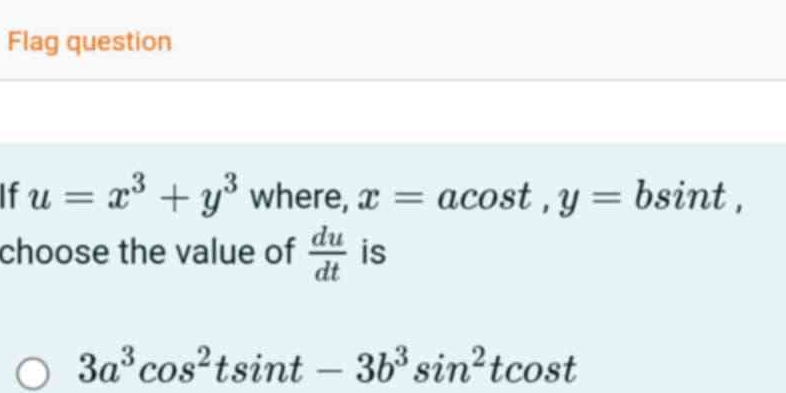If $u = x^3 + y^3$ where $x = a \cos(t)$, $y = b \sin(t)$, choose the value of $\frac{du}{dt}$.

Understand the Problem
The question asks us to find the derivative of $u$ with respect to $t$, given that $u = x^3 + y^3$, $x = a \cos(t)$, and $y = b \sin(t)$. We need to apply the chain rule to find $\frac{du}{dt}$.
Answer
$3b^3 \sin^2(t) \cos(t) - 3a^3 \cos^2(t) \sin(t)$
Answer for screen readers
$3b^3 \sin^2(t) \cos(t) - 3a^3 \cos^2(t) \sin(t)$
Steps to Solve
-
Find $\frac{du}{dx}$ Differentiate $u = x^3 + y^3$ with respect to $x$, treating $y$ as a function of $x$.
$\frac{du}{dx} = 3x^2$
-
Find $\frac{du}{dy}$ Differentiate $u = x^3 + y^3$ with respect to $y$, treating $x$ as a function of $y$.
$\frac{du}{dy} = 3y^2$
-
Find $\frac{dx}{dt}$ Differentiate $x = a \cos(t)$ with respect to $t$.
$\frac{dx}{dt} = -a \sin(t)$
-
Find $\frac{dy}{dt}$ Differentiate $y = b \sin(t)$ with respect to $t$.
$\frac{dy}{dt} = b \cos(t)$
-
Apply the chain rule Using the chain rule, we have: $\frac{du}{dt} = \frac{du}{dx} \cdot \frac{dx}{dt} + \frac{du}{dy} \cdot \frac{dy}{dt}$
-
Substitute the derivatives Substitute the derivatives we found in the previous steps: $\frac{du}{dt} = (3x^2)(-a \sin(t)) + (3y^2)(b \cos(t))$
-
Substitute $x$ and $y$ Substitute $x = a \cos(t)$ and $y = b \sin(t)$ into the equation: $\frac{du}{dt} = 3(a \cos(t))^2(-a \sin(t)) + 3(b \sin(t))^2(b \cos(t))$
-
Simplify Simplify the expression: $\frac{du}{dt} = -3a^3 \cos^2(t) \sin(t) + 3b^3 \sin^2(t) \cos(t)$ $\frac{du}{dt} = 3b^3 \sin^2(t) \cos(t) - 3a^3 \cos^2(t) \sin(t)$
$3b^3 \sin^2(t) \cos(t) - 3a^3 \cos^2(t) \sin(t)$
More Information
The chain rule is a fundamental concept in calculus that allows us to find the derivative of a composite function.
Tips
A common mistake would be to forget to apply the chain rule correctly, or to incorrectly differentiate the trigonometric functions. Another mistake could be made when substituting $x$ and $y$ back into the equation.
AI-generated content may contain errors. Please verify critical information